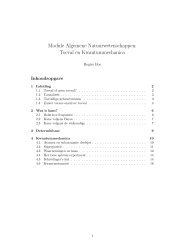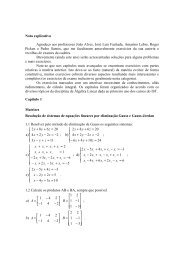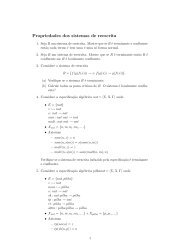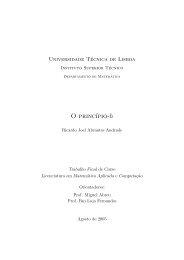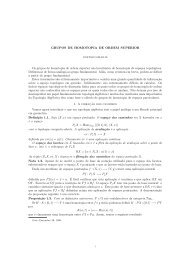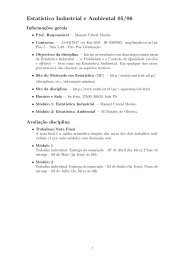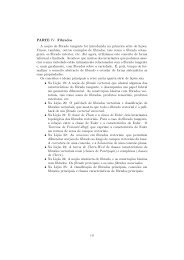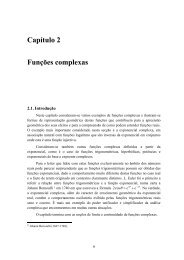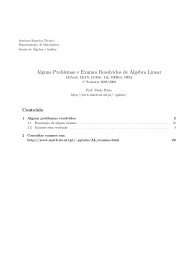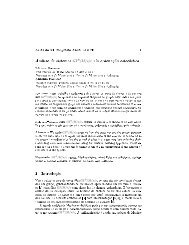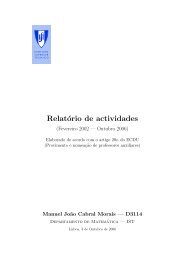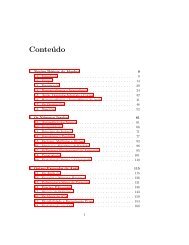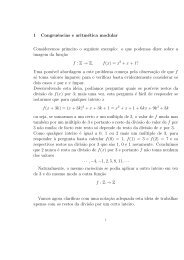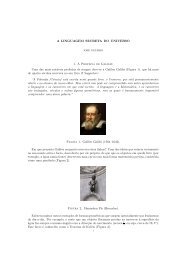Exercícios de Cálculo Integral e Diferencial I
Exercícios de Cálculo Integral e Diferencial I
Exercícios de Cálculo Integral e Diferencial I
You also want an ePaper? Increase the reach of your titles
YUMPU automatically turns print PDFs into web optimized ePapers that Google loves.
1. Determine os seguintes limites:<br />
2. Calcule<br />
10<br />
a) lim<br />
x→0<br />
x − 5x x<br />
6 a Ficha <strong>de</strong> problemas<br />
Funções reais. Diferenciabilida<strong>de</strong><br />
b) lim<br />
x→0 +<br />
x2 sen ( 1<br />
x )<br />
sen x<br />
1<br />
x<br />
a) lim (ln x) x b) lim (sen x)sen<br />
x→+∞ x→0 +<br />
c) lim<br />
x→0 +<br />
c) lim<br />
x→0 +<br />
3. Seja f : [− 1 1 , 2 2 ] → R tal que f(x) = arctg(x2 ) + 1<br />
1<br />
− e x<br />
x<br />
ln x<br />
x 2 e ln2 x<br />
1<br />
d) lim x x−1<br />
x→+∞<br />
coth x<br />
d) lim (ch x)<br />
x→0<br />
a) Determine o polinómio <strong>de</strong> Taylor <strong>de</strong> 2 o grau em potências <strong>de</strong> x.<br />
b) Determine um majorante para o erro que se comete em [−1/2, 1/2] ao aproximar<br />
f pelo polinómio indicado em a).<br />
4. Prove que se g : R → R é três vezes diferenciável e se g ′′′ (x) > 0, ∀x ∈ R, então<br />
g não po<strong>de</strong> ter mais do que dois pontos <strong>de</strong> extremo local. Admitindo agora que<br />
g tem <strong>de</strong> facto extremos locais em α e β, com α < β, indique se g(α) e g(β) são<br />
máximos ou mínimos da função. Justifique.<br />
Escreva a fórmula <strong>de</strong> Taylor para g e com resto <strong>de</strong> Lagrange <strong>de</strong> segunda or<strong>de</strong>m<br />
e aproveite-a para mostrar que g(x) > g(β) para x > β.<br />
5. Seja f : R → R, f(x) = |x|e 1−x2<br />
a) Estu<strong>de</strong> a função f do ponto <strong>de</strong> vista da continuida<strong>de</strong> e da diferenciabilida<strong>de</strong>.<br />
Em cada ponto em que f não seja diferenciável, calcule as <strong>de</strong>rivadas laterais.<br />
b) Complete o estudo da função f, consi<strong>de</strong>rando em particular os aspectos seguintes:<br />
crescimento, extremos, concavida<strong>de</strong>, inflexões e assíntotas. Esboce<br />
o gráfico da função f.<br />
13




